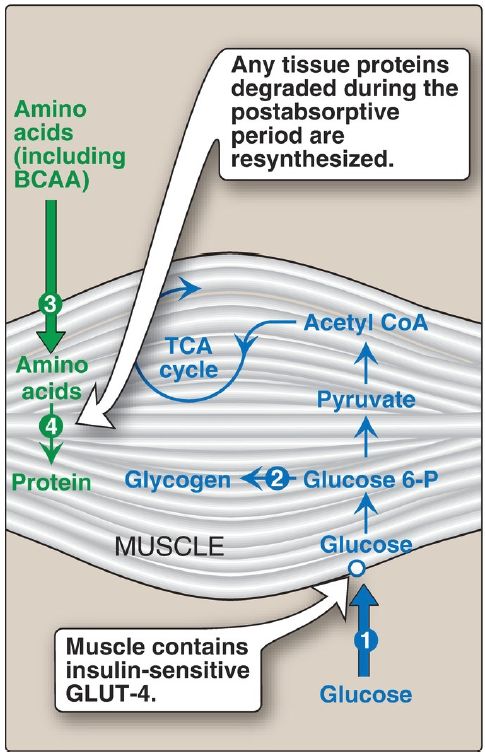
Resting Skeletal Muscle
 المؤلف:
Denise R. Ferrier
المؤلف:
Denise R. Ferrier
 المصدر:
Lippincott Illustrated Reviews: Biochemistry
المصدر:
Lippincott Illustrated Reviews: Biochemistry
 الجزء والصفحة:
الجزء والصفحة:
 24-11-2021
24-11-2021
 2001
2001
Resting Skeletal Muscle
Skeletal muscle accounts for ~40% of the body mass in individuals of healthy weight, and it can use glucose, amino acids, FA, and ketone bodies as fuel. In the well-fed state, muscle takes up glucose via GLUT-4 (for energy and glycogen synthesis) and amino acids (for energy and protein synthesis). In contrast to liver, there is no covalent regulation of PFK-2 in skeletal muscle. However, in the cardiac isozyme, the kinase domain is activated by epinephrine-mediated phosphorylation .
Skeletal muscle is unique in being able to respond to substantial changes in the demand for ATP that accompanies contraction. At rest, muscle accounts for ~25% of the oxygen (O2) consumption of the body, whereas during vigorous exercise, it is responsible for up to 90%. This underscores the fact that skeletal muscle, despite its potential for transient periods of anaerobic glycolysis, is an oxidative tissue.
A. Carbohydrate metabolism
1. Increased glucose transport: The transient increase in plasma glucose and insulin after a carbohydrate-rich meal leads to an increase in glucose transport into muscle cells (myocytes) by GLUT-4 ( Fig. 1, ), thereby reducing blood glucose. Glucose is phosphorylated to glucose 6-phosphate by hexokinase and metabolized to meet the energy needs of myocytes.

Figure 1: Major metabolic pathways in skeletal muscle in the absorptive state. [Note: The numbers in circles, which appear both in the figure and in the text, indicate important pathways for carbohydrate or protein metabolism.] CoA = coenzyme A; P = phosphate; GLUT = glucose transporter; BCAA = branchedchain amino acids; TCA = tricarboxylic acid.
2. Increased glycogenesis: The increased insulin/glucagon ratio and the availability of glucose 6-phosphate favor glycogen synthesis, particularly if glycogen stores have been depleted as a result of exercise (Fig. 1, ).
B. Fat metabolism
FA are released from chylomicrons and VLDL by the action of LPL . However, FA are of secondary importance as a fuel for resting muscle during the well-fed state, in which glucose is the primary source of energy.
C. Amino acid metabolism
1. Increased protein synthesis: An increase in amino acid uptake and protein synthesis occurs in the absorptive period after ingestion of a meal containing protein (see Fig. 1, and ). This synthesis replaces protein degraded since the previous meal.
2. Increased branched-chain amino acid uptake: Muscle is the principal site for degradation of the BCAA because it contains the required transaminase . The dietary BCAA escape metabolism by the liver and are taken up by muscle, where they are used for protein synthesis (see Fig. 1, ) and as energy sources.
 الاكثر قراءة في الكيمياء الحيوية
الاكثر قراءة في الكيمياء الحيوية
 اخر الاخبار
اخر الاخبار
اخبار العتبة العباسية المقدسة


